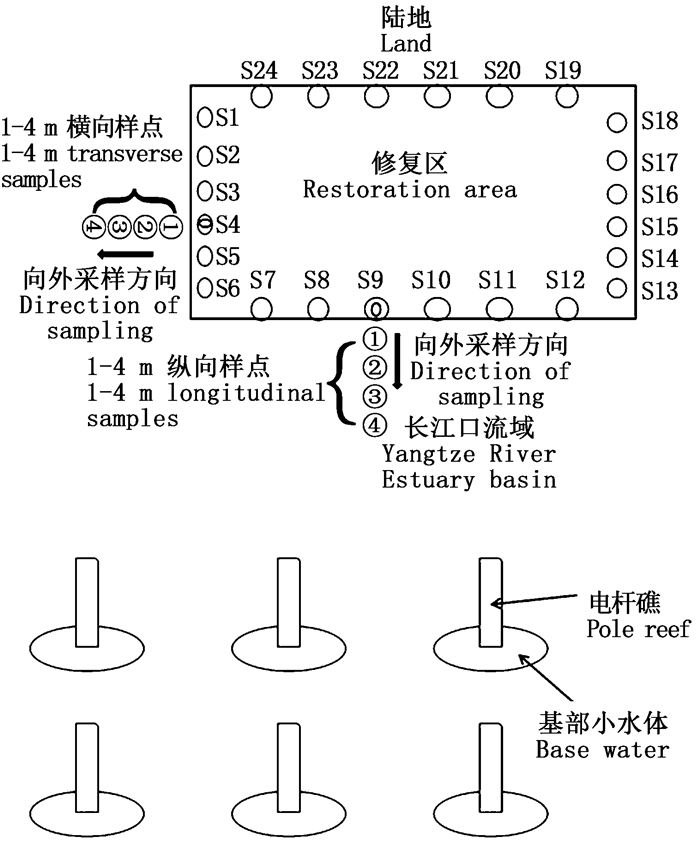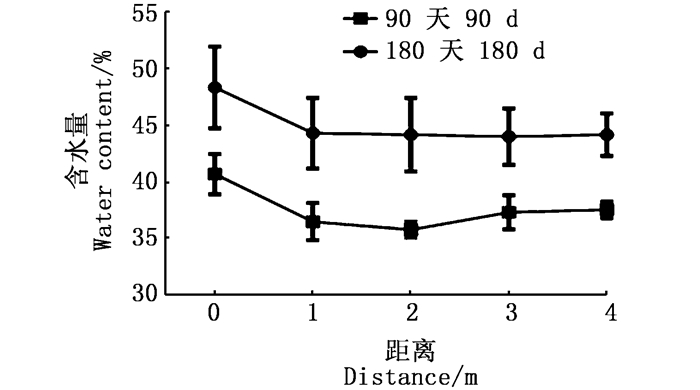2. 上海海洋大学 港航生态安全研究中心, 上海 201306
潮间带滩涂是连接海洋与陆地的生态交错带,容易受人类活动影响[1]。随着社会的发展,土地资源日益紧张,滩涂围垦成为很多沿海城市发展的必然选择。频繁的开发利用对滩涂生态环境造成了严重的破坏,出现了如纳潮量减少、海水自净能力减弱、降解污染速率下降等问题,进而诱发海水水质恶化、近海污染、海洋生物资源退化、天然湿地减少、鸟类减少、海岸带的生物多样性下降、湿地破坏严重等问题[2-4]。
长江口地区地势较缓,入海口处由崇明岛分为南北两支,南支又在长兴岛等岛屿的分割作用下分为南槽和北槽,南槽靠近浦东机场。近年来由于发展需要,浦东机场外围进行了一系列的围垦。滩涂围垦不仅影响了围垦区内的生物多样性,同时也造成了周围环境如流场、盐度、土壤等的改变[5-9]。同时该区域靠近九段沙水域,围垦活动可能会对九段沙湿地的生态系统产生影响[10-11]。
滩涂生态修复,是通过适当的人为干预和引导, 利用生物与环境的特点, 增加物种丰富度,改善和恢复环境的稳定性[12]。滩涂围垦区外的生态修复既是一种保护措施,也是对生态破坏后的围垦区的一种补偿[13]。针对围垦区域外的生态修复补偿,常用的方法有生物修复、物理修复和化学修复等[14-17]。本研究开展的区域为浦东机场外围与川杨河附近的潮间带滩涂。该区域位于河流出口处,且位于两个围区之间,受围垦的影响较为明显。由于本区域靠近机场,大量种植植物会引起鸟类的聚集,从而对机场的正常运行产生威胁。该滩涂区域目前环境还未彻底破坏,土壤无需进行前期的化学修复。因河口内有渔船停泊区,往来船只较为频繁,大型的渔礁抛石会影响船只航行,同时还会加速泥沙沉积,因此物理修复技术中常用的人工鱼礁[18-21]方法也不适用。
结合以上因素,在浦东机场外围生态修复区选择使用了与常规渔礁不同的电杆礁生态修复措施。在水流的作用下,电杆礁基部形成小水体,构成生态微环境,影响退潮期间周边滩涂的含水量,促进生物的附着,并为底栖生物及退潮期间滞留的鱼类、蟹类等提供生存空间和饵料资源等。本研究分析了电杆礁修复对修复区及其周边含水量的影响,为优化河口滩涂湿地修复和底栖生物生存的研究提供更多的数据支撑,并为类似的滩涂生态修复提供参考依据。
1 材料与方法研究区域地势平缓,位于长江口九段沙浦东机场外围滩涂围垦区外侧,电杆礁生态修复区设计为长200 m、宽50 m的无明显潮差的长方形区域(图 1)。在该10 000 m2面积中平均打入10 000根电杆礁,电杆礁为高度1 m,底部边长为10 cm的立方形柱体结构,电杆礁之间距离约为1 m,计划打入深度为50 cm,后续因不同区域土壤地质的情况不同,出现不同程度的冲刷,电杆礁地上高度也不完全相同。电杆礁结合潮间带水流的特性形成了围绕电杆礁基部的小水体。本实验于2017年5月和2017年9月对滩涂修复区小水体周围沉积土样含水量和电杆礁施工形成的小水体数据进行测量。沉积土样含水量研究按照修复区分为4个部分(修复区长方形的每个边为1个组),共设置24个样方(S1~S24)。每个样方以电杆礁基部小水体外沿为起点,向修复区外延伸(图 2),间隔为1 m,采集5组沉积土样测定含水量(总计120个样品),沿电杆礁基部平行于海岸线向修复区外延的样点为横向样点,垂直于海岸线方向向修复区外延伸的样点为纵向样点(图 2)。

|
图 1 浦东机场外围修复区位置示意图 Fig. 1 Location of repair area outside Pudong Airport |

|
图 2 电杆礁修复区采样点示意图 Fig. 2 Schematic diagram of sampling points in the repair area of the pole reef |
沉积土样的采集和分析依照烘干法测定土壤含水量,称取一定量的样品放置在铝盒中,在105 ℃±2 ℃的条件下烘6 h,迅速转移到干燥室内冷却至室温后称重。每个样本测量重复两次,两次称重的差值恒定,则差值即为土壤的含水量。土壤粒径的测量使用Mastersizer 2000粒径分析仪进行沉积土样粒径的组成分析,每个样品进行3次平行测量记录数值。对比不同情况下电杆礁修复区中各点及区域之间的差异,分析电杆礁修复技术对栖息地的影响。
在10 000个小水体中随机选择30个小水体作为样本进行数据统计和分析,测量了水坑的直径、深度、体积以及电杆礁地上高度,采用SPSS 18.0对电杆礁地上高度与小水体直径、深度和体积的关系分别进行分析,研究各参数之间的相关性。对所有含水量样品两次平行样的结果进行均值化处理,所得最终结果后续分析的折线图与柱状图使用GraphPad Prism 6软件绘制。不同组别之间的方差分析使用SPSS 18.0分析得出结果。
2 结果与分析 2.1 电杆礁地上高度与基部小水体体积关系电杆礁基部小水体的底部直径范围为13.5~24.0 cm、表面直径范围为35.0~64.0 cm、深度范围为10.0~25.5 cm,水体体积范围为4.5~21.8 L、电杆礁地上高度的范围为15.3~53.3 cm(表 1),不同小水体的体积差异较大。分析内径、外径、水坑深度和电杆礁地上高度与小水体体积的相关性,结果显示电杆礁地上高度与所对应的水体体积具有一定相关性(P=0.035),电杆礁地上高度与水体体积的大小呈正相关。进一步的分析显示, 电杆礁地上高度可分为 < 36 cm、36~50 cm和 > 50 cm 3个组,方差同质性检验P > 0.05,满足方差齐性。单因素ANOVA分析显示,3组之间基部小水体体积均存在显著差异(P < 0.01),其中 < 36 cm组的平均体积为(7.77±2.44) L,36~50 cm组的平均体积为(8.96±1.88) L,> 50 cm组的平均体积为(16.4±5.36) L,显示在本次电杆礁生态修复模式下,电杆礁地上高度影响其基部小水体的体积,随着电杆礁地上高度的增高,小水体体积逐渐增大。

|
表 1 电杆礁及基部水体参数结果 Tab.1 Results of pole reef and base water parameters |
比较修复时间为180 d和90 d的沉积土样,结果显示修复时间较长(180 d)的滩涂沉积土样(S1~S9,S22~S24)含水量高于修复时间短(90 d)的滩涂沉积土样(S10~S21)含水量(图 3)。0~1 m处采样组的差异最为明显,修复时间较长区域0 m处含水量48.41%,而修复时间较短的区域0 m处含水量为40.73%。修复时间较长的区域1 m外的含水量基本高于44%,修复时间较短的区域1 m外的含水量都低于38%。

|
图 3 不同修复时间的含水量区别 Fig. 3 The water content at different repair time |
对近岸与远岸的不同样品之间比较,结果显示近岸样方(S19~S24)沉积土样中含水量均高于远岸样方(S7~S12)含水量,近岸侧含水量的均值为50.56%,远岸侧只有在距离电杆礁0 m处的含水量为41.72%,其他各点的含水量均小于40%(图 4)。分析S14~S17各点之间含水量的差异,结果显示含水量范围为36.12%~38.14%,且含水量大小并没有按照离岸越近含水量越高的方式分布。同时,对近岸和远岸两侧的沉积土样粒径进行分析,结果显示:近岸侧滩涂中颗粒粒径的比表面积为0.933 m2/g,远岸侧的粒径比表面积为0.891 m2/g;滩涂中小于2 μm的蓄水能力较强的黏土所占比例也不同,近岸滩涂中的含量为8.39%,远岸侧中的含量为7.54%。

|
图 4 近岸与远岸的含水量比较 Fig. 4 Comparison of water content between inshore and distant shore |
对横向样点和纵向样点的样品1~4 m各样点的含水量进行分析,结果显示纵向样点(S7~S12的1~4 m样点)的含水量的范围为43.16%~52.85%,而横向样点(S13~S18的1~4 m样点)的含水量范围为23.95%~46.29%,纵向样点的含水量均值明显高于横向样点的含水量(图 5),方差分析结果为P=0.013,具有一定的差异性。

|
图 5 修复区纵向和横向样点的含水量 Fig. 5 Water content of longitudinal and transverse spline in repair area |
在滩涂修复的过程中,电杆礁基部会形成小水体,基部水体的大小与电杆礁地上高度有一定的关系。相关研究[22]指出,水流在刚性植被的阵列中产生涡流造成水流动量和能量的耗散,并进而影响悬移质的输运以及河流形态演变。由于柱体绕流的特点,潮汐和海浪在运动的过程中,围绕电杆礁基部形成涡流,使得电杆礁基部水流紊乱,带动周围泥沙转移,随着时间的推移就围绕电杆礁基部形成小水体[23-24]。电杆礁及其基部水体的形成,为生物提供了一个优良的栖息环境。修复区含水量及沉积土质条件发生改变,改善底栖生物的生存条件[25-26]。电杆礁礁体为藻类提供附着生长的场所,基部水体可供部分游泳动物生存,避免退潮过程造成的失水死亡[27-29]。
刚性体在非淹没状态下,非淹没高度与湍流作用呈正相关[30]。水流受湍流的影响,产生尾流区,局部加快水流速度,则该区域的物质迁移随时发生。潮汐及海浪引起的水流变化都是湍流,在一定的密度条件下,不同的电杆礁地上高度对湍流结构影响明显[31-32]。电杆礁地上高度决定电杆礁非淹没高度及在潮汐作用下非淹没状态维持的时间,因此电杆礁不同的地上高度与小水体的大小有一定的关系。同时,在一定地上高度条件下,合理的种植密度也是决定湍流结构的另一项因素,不同的密度作用下,水流的不同方向的湍流强度不同,小水体的直径因为不同湍流强度的力而发生差异,影响沉积物迁移[33-35],导致小水体蓄水体积的不同。
电杆礁修复区中,不同区域的含水量变化并不完全相同,修复区近岸一侧含水量明显高于远岸一侧,且土样组成粒径也不相同。根据相关学者在刚性结构对水流的阻力方面进行的研究[36-40],显示刚性结构会使水流在进入刚性体构成的阵列前流速下降,造成物质沉积。因此在受到相同涡流影响下,远岸一侧受电杆礁修复区对水流阻力的影响,较多的大颗粒土壤和物质沉降,本身蓄水能力差,远岸侧的电杆礁周围的蓄水能力就相对较低。较小粒径的物质穿过修复区的过程中由于电杆礁的存在,海浪的运动速度及能量受到延缓,最终部分物质留在近岸,岸边土壤受冲刷后也会有大部分留在近岸,整体蓄水能力较强,水流回流向海的动力不足积蓄在近岸,因此近岸的土样中的含水量相对较高。
通过对修复区周围滩涂沉积土样含水量的分析发现,小水体向修复区外延伸样点的含水量变化并非完全一致。纵向向外延伸的样点受到电杆礁对水流以及泥沙的阻力作用,而横向向外延伸的样点基本不受电杆礁的影响,所以纵向延伸样点含水量高于横向样点含水量。关于近岸的人工凸体的研究也表明,人工凸体对垂直于海岸的方向上的水流及泥沙作用明显,能够改变滩涂的土壤情况[41]。电杆礁修复区外纵向延伸样点的各个样点受湍流本身的速度以及电杆礁在纵向延伸方向上对水流的阻力影响,含水量有所上升。
| [1] |
刘慧, 孔光耀. 生态交错带及其边缘效应的研究进展[J]. 中学生物教学, 2006(11): 4-5. LIU H, KONG G Y. Advances in the study of ecotone and its marginal effects[J]. Middle School Biology Teaching, 2006(11): 4-5. |
| [2] |
小田弘雄, 蒲廷芬. 与海的威胁进行斗争-介绍荷兰的围垦工程[J]. 水利水运科技情报, 1975(6): 86-93. HIROSHI O D A, PU T F. Fighting the threat of the sea:introduction to the Dutch Reclamation Project[J]. Information on Water Transport Technology, 1975(6): 86-93. |
| [3] |
李荣军. 荷兰围海造地的启示[J]. 海洋开发与管理, 2006, 23(3): 31-34. LI R J. Illumination getting from encircling the sea to make land in Netherlands[J]. Ocean Development and Management, 2006, 23(3): 31-34. DOI:10.3969/j.issn.1005-9857.2006.03.008 |
| [4] |
陶鼎来. 荷兰、韩国围海造田成就斐然[J]. 世界农业, 1996(10): 46-48. TAO D L. The Netherlands, South Korea have made great achievements in reclaiming land from the sea[J]. World Agriculture, 1996(10): 46-48. |
| [5] |
李明霞. 厦门九成原生红树林遭破坏[J]. 园林科技, 2008(1): 50. LI M X. 90% of the original mangroves in Xiamen were destroyed[J]. Garden Science and Technology, 2008(1): 50. |
| [6] |
王志勇, 赵庆良, 邓岳, 等. 围海造陆形成后对生态环境和渔业资源的影响——以天津临港工业区滩涂开发一期工程为例[J]. 城市环境与城市生态, 2004, 17(6): 37-39. WANG Z Y, ZHAO Q L, DENG Y, et al. Effect of reclamation project to ecological environment and fishery resource——taking the exploit seabeach first project of Tianjin industrial abuting on the port[J]. Urban Environment & Urban Ecology, 2004, 17(6): 37-39. |
| [7] |
张长宽, 陈欣迪. 海岸带滩涂资源的开发利用与保护研究进展[J]. 河海大学学报(自然科学版), 2016, 44(1): 25-33. ZHANG C K, CHEN X D. Advances in development, utilization, and protection of coastal tidal flats[J]. Journal of Hohai University (Natural Sciences), 2016, 44(1): 25-33. DOI:10.3876/j.issn.1000-1980.2016.01.005 |
| [8] |
夏立群, 张红莲, 简纪常, 等. 植物修复技术在近海污染治理中的研究与应用[J]. 水资源保护, 2005, 21(1): 32-35. XIA L Q, ZHANG H L, JIAN J C, et al. Study on the application of phytoremediation technology to the treatment of wastewater in the coastal sea[J]. Water Resources Protection, 2005, 21(1): 32-35. DOI:10.3969/j.issn.1004-6933.2005.01.010 |
| [9] |
林黎, 崔军, 陈学萍, 等. 滩涂围垦和土地利用对土壤微生物群落的影响[J]. 生态学报, 2014, 34(4): 899-906. LIN L, CUI J, CHEN X P, et al. Effects of reclamation on tidal fiat and land use on soil microbial community[J]. Acta Ecologica Sinica, 2014, 34(4): 899-906. |
| [10] |
周春煦. 九段沙沙洲演变及其与水沙变化的响应关系[J]. 水电能源科学, 2017, 35(12): 78-81. ZHOU C X. Response relationship of evolution of Jiuduansha island to water and sediment variation[J]. Water Resources and Power, 2017, 35(12): 78-81. |
| [11] |
陈吉余, 李道季, 金文华. 浦东国际机场东移与九段沙生态工程[J]. 中国工程科学, 2001, 3(4): 1-8. CHEN J Y, LI D J, JIN W H. Eco-engineering of Jiuduansha island caused by Pudong international airport construction[J]. Engineering Science, 2001, 3(4): 1-8. DOI:10.3969/j.issn.1009-1742.2001.04.001 |
| [12] |
张思琦.基于河流生态修复理念的城市滨水空间景观设计研究[D].北京: 北京林业大学, 2016. ZHANG S Q. The landscape design of urban waterfront areas based on the concept of river restoration[D]. Beijing: Beijing Forestry University, 2016. http://cdmd.cnki.com.cn/Article/CDMD-10022-1016140190.htm |
| [13] |
王昱.区域生态补偿的基础理论与实践问题研究[D].长春: 东北师范大学, 2009. WANG Y. The exploring in fundamental theories and practical issues of regional ecological compensation[D]. Changchun: Northeast Normal University, 2009. http://www.wanfangdata.com.cn/details/detail.do?_type=degree&id=Y1467200 |
| [14] |
毛玉梅.烟气脱硫石膏改良围垦滩涂盐碱土研究[D].上海: 华东师范大学, 2016. MAO Y M. Flue gas desulfurization gypsum improving saline-sodic soil in tidal flats[D]. Shanghai: East China Normal University, 2016. http://cdmd.cnki.com.cn/Article/CDMD-10269-1016145819.htm |
| [15] |
陈彩成.滩涂沉积物石油污染高级氧化修复及健康风险后评估技术研究[D].上海: 华东理工大学, 2016. CHEN C C. Advanced oxidation remediation and post health risk assessment of petroleum-contaminated sediment in the tidal flats[D]. Shanghai: East China University of Science and Technology, 2016. http://cdmd.cnki.com.cn/Article/CDMD-10251-1016097717.htm |
| [16] |
纪录, 张晖. 原位化学氧化法在土壤和地下水修复中的研究进展[J]. 环境污染治理技术与设备, 2003, 4(6): 37-42. JI L, ZHANG H. The progress in soil and groundwater remediation by in situ chemical oxidation[J]. Techniques and Equipment for Environmental Pollution Control, 2003, 4(6): 37-42. |
| [17] |
刘针铃. Eh交替变化与海水淋洗对围垦滩涂土壤重金属污染的联合修复[D].广州: 暨南大学, 2014. LIU Z L. Remediation on reclaimed tidal soil polluted with heavy metals by sea-water leaching combined Eh alternating change[D]. Guangzhou: Ji'nan University, 2014. http://cdmd.cnki.com.cn/Article/CDMD-10559-1015002058.htm |
| [18] |
符小明.人工鱼礁修复海洋生态系统的效果评价——以海州湾为例[D].上海: 上海海洋大学, 2016. FU X M. Evaluate the effectiveness of marine ecological rehabilitation using artificial reef-a case study of Haizhou bay[D]. Shanghai: Shanghai Ocean University, 2016. http://cdmd.cnki.com.cn/Article/CDMD-10264-1016912655.htm |
| [19] |
兰孝政.圆台型人工鱼礁流场效应的数值模拟研究[D].青岛: 中国海洋大学, 2015. LAN X Z. Numerical simulations of the flow field around artificial reefs with truncated-cone shape[D]. Qingdao: Ocean University of China, 2015. http://cdmd.cnki.com.cn/Article/CDMD-10423-1015717176.htm |
| [20] |
赵峰, 黄孝锋, 张涛, 等. 利用人工飘浮湿地恢复长江口生物多样性研究初探[J]. 渔业信息与战略, 2015, 30(4): 288-292. ZHAO F, HUANG X F, ZHANG T, et al. Preliminary study on artificial floating wetland for biodiversity restoration in the Yangtze Estuary[J]. Fishery Information & Strategy, 2015, 30(4): 288-292. |
| [21] |
NAKAMURA K, KADOKURA N, MUNAKTA Y, et al. Restorarion of lakeshore vegetation by artificial floating island[J]. Environmental Systems Research, 1999, 27: 305-314. DOI:10.2208/proer1988.27.305 |
| [22] |
王中玉.渐变流植被河道水动力学机制研究[D].北京: 华北电力大学(北京), 2016. WANG Z Y. Research on the hydraulic mechanisms of gradually varied flow in vegetated channels[D]. Beijing: North China Electric Power University (Beijing), 2016. http://cdmd.cnki.com.cn/Article/CDMD-11412-1016270671.htm |
| [23] |
于定勇, 赵建豪, 黄东燕, 等. 不同倒角半径柱体绕流数值模拟及水动力特性分析[J]. 海洋工程, 2018, 36(5): 1-11. YU D Y, ZHAO J H, HUANG D Y, et al. Numerical simulation of flow past a cylinder with different rounded radius and analysis of hydrodynamic characteristics[J]. The Ocean Engineering, 2018, 36(5): 1-11. |
| [24] |
端木玉, 万德成. 不同长细比圆柱绕流的大涡模拟[J]. 水动力学研究与进展, 2016, 31A(3): 295-302. DUAN M Y, WAN D C. Large eddy simulation of flow around the cylinders with different aspects[J]. Chinese Journal of Hydrodynamics, 2016, 31A(3): 295-302. |
| [25] |
刘建康. 高级水生生物学[M]. 北京: 科学出版社, 1999. LIU J K. Advanced aquatic biology[M]. Beijing: Science Press, 1999. |
| [26] |
段学花, 王兆印, 田世民. 河床底质对大型底栖动物多样性影响的野外试验[J]. 清华大学学报(自然科学版), 2007, 47(9): 1553-1556. DUAN X H, WANG Z Y, TIAN S M. Field experiment on the effect of streambed substrate on macroinvertebrate diversity[J]. Journal of Tsinghua University (Science and Technology), 2007, 47(9): 1553-1556. DOI:10.3321/j.issn:1000-0054.2007.09.016 |
| [27] |
宋玉芝, 张亚冬, 郑建伟, 等. 淡水湖泊附着藻类生态学研究进展[J]. 生态学杂志, 2016, 35(2): 534-541. SONG Y Z, ZHANG Y D, ZHENG J W, et al. Periphytic algae ecology in freshwater lake:a review[J]. Chinese Journal of Ecology, 2016, 35(2): 534-541. |
| [28] |
DODDS W K. The role of periphyton in phosphorus retention in shallow freshwater aquatic systems[J]. Journal of Phycology, 2003, 39(5): 840-849. DOI:10.1046/j.1529-8817.2003.02081.x |
| [29] |
秦伯强, 宋玉芝, 高光. 附着生物在浅水富营养化湖泊藻-草型生态系统转化过程中的作用[J]. 中国科学C辑生命科学, 2006, 36(3): 283-288. QIN B Q, SONG Y Z, GAO G. The role of periphytes in the shift between macrophyte and phytoplankton dominated systems in a shallow, eutrophic lake (Lake Taihu, China)[J]. Science in China Series C:Life Sciences, 2006, 36(3): 283-288. |
| [30] |
MCARTHUR A A. Reviewed work:government policy and industrial change by david gibb[J]. Transactions of the Institute of British Geographers, 1990, 15(1): 123-125. DOI:10.2307/623103 |
| [31] |
TANG H W, TIAN Z J, YAN J, et al. Determining drag coefficients and their application in modelling of turbulent flow with submerged vegetation[J]. Advances in Water Resources, 2014, 69: 134-145. DOI:10.1016/j.advwatres.2014.04.006 |
| [32] |
STANG C, WIECZOREK M V, NOSS C, et al. Role of submerged vegetation in the retention processes of three plant protection products in flow-through stream mesocosms[J]. Chemosphere, 2014, 107: 13-22. DOI:10.1016/j.chemosphere.2014.02.055 |
| [33] |
NEARY V S, CONSTANTINESCU S G, BENNETT S J, et al. Effects of vegetation on turbulence, sediment transport, and stream morphology[J]. Journal of Hydraulic Engineering, 2012, 138(9): 765-776. DOI:10.1061/(ASCE)HY.1943-7900.0000168 |
| [34] |
AFZALIMEHR H, DEY S. Influence of bank vegetation and gravel bed on velocity and Reynolds stress distributions[J]. International Journal of Sediment Research, 2009, 24(2): 236-246. DOI:10.1016/S1001-6279(09)60030-5 |
| [35] |
DEVI T B, DAGA R, MAHTO S K, et al. Drag and turbulent characteristics of mobile bed channel with mixed vegetation densities under downward seepage[J]. Journal of Fluids Engineering, 2016, 138(7): 071104. DOI:10.1115/1.4032753 |
| [36] |
KOUWEN N, LI R M. Biomechanics of vegetative channel linings[J]. Journal of the Hydraulics Division, 1980, 106(6): 1085-1103. |
| [37] |
GREEN J C. Modelling flow resistance in vegetated streams:review and development of new theory[J]. Hydrological Processes, 2005, 19(6): 1245-1259. DOI:10.1002/(ISSN)1099-1085 |
| [38] |
CHEN Y C, KAO S P, LIN J Y, et al. Retardance coefficient of vegetated channels estimated by the Froude number[J]. Ecological Engineering, 2009, 35(7): 1027-1035. DOI:10.1016/j.ecoleng.2009.03.002 |
| [39] |
LEE J K, ROIG L C, JENTER H L, et al. Drag coefficients for modeling flow through emergent vegetation in the Florida Everglades[J]. Ecological Engineering, 2004, 22(4/5): 237-248. |
| [40] |
ZHANG H Y, WANG Z Y, XU W G, et al. Effects of rigid unsubmerged vegetation on flow field structure and turbulent kinetic energy of gradually varied flow[J]. River Research and Applications, 2015, 31(9): 1166-1175. DOI:10.1002/rra.v31.9 |
| [41] |
吴建.近海人工凸体保滩促淤的试验研究[D].青岛: 中国海洋大学, 2010. WU J. Experimental study on the artificial convex structure for beasch protection and siltation promotion[D]. Qingdao: Ocean University of China, 2010. http://cdmd.cnki.com.cn/Article/CDMD-10423-1011230543.htm |
2. Centre for Research on the Ecological Security of Ports and Shipping, Shanghai 201306, China
 2019,
Vol. 28
2019,
Vol. 28


